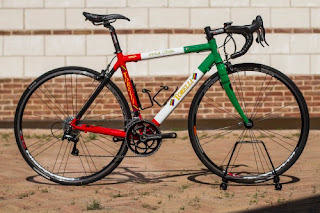RIP Drop handlebars
News that a racer was DQ'd recently based on the "puppy-paw" position she used briefly in a race made Zio Lorenzo think.
Or course drop handlebars haven’t died, but in some ways “rest-in-peace”
still applies.
What happened? Don’t racers still use them? Of course, but they
rarely put their hands on the dropped part these days. Until recently the rules let them drape their
forearms over the bar top with hands out-front, touching nothing. Some dubbed
this “puppy paws” but it simulated an aero-bar position (remember the old Cinelli "Spinaci" and the copies?) and evidently was
superior against the wind vs riding with hands down in the drops. But for safety
reasons the UCI banned it, making the riders at least maintain a semblance of
grip on the handlebars. They banned the silly “super-tuck” (sitting on the top
tube) position around the same time, but that’s a topic for another time.
Now they keep their hands on the brake hoods but try to keep forearms straight as in the now-banned “puppy paw” position, sometimes even laying them across the bar, but as long as their hands aren’t sticking out into thin-air it’s OK. Modern brake/shift levers with hydraulic cylinders inside are longer than the old cable brake style which helps them stretch out a bit more, but unless they’re descending quickly or sprinting, you rarely see many hands on the drops these days.
Drops are not so “droppy” nowadays either*. Back-in-the-day when Cinelli bars were king, there was the deep drop # 66 Campione del Mondo (no longer on Cinelli’s website – just too “droppy”?) and the not so deep #64 Giro d’Italia along with other copies. All had much deeper drops than you see these days. So-called “anatomic” bars came along after but despite their flattened rather than curved sections the drop remained pretty much the same.
But now everyone could see how many spacers you had (or didn’t)
under your threadless stem, even if you flipped it upside down (compared to the
pros anyway) to get a positive rather than negative rise…you were “slammed”
and thus in-fashion! Maybe the tops of your bars (therefore the brake hoods as well)
ended up lower than what you used with a quill stem, but you were in-fashion,
so who cared? Plenty of bike-mag articles were written about the merits (fashion
and otherwise) of “slamming that stem!”
Perhaps as a result a lot of the head tubes on so-called “endurance
bikes” got taller so those “slammed” stems could still get the bars higher up,
but on “racing” bikes the overall lowering meant your drops might now be way-too-low.
The answer? “Compact” bars! Really shallow drops (sometimes
so shallow your forearms hit the top when you reach down) soon became the norm.
In comparison the drop on a not-so-deep-drop bar like the old Cinelli 64 seems
huge these days. Hands on drops or hoods? It made little difference to your aerodynamic
drag it seemed, so why bother with drops, especially when getting down there
might put pressure on your sensitive regions since the bars (and therefore the drops)
were too low if you followed that “slam” fashion?
The result is you see even the pros rarely bother these days. Modern hydraulic brake systems are so powerful a rider can get plenty of braking power despite the reduced leverage with hands on the brake hoods, so even on technical descents they’re as likely to put hands up there as on the drops.
Some riders have also tried super-narrow bars while others have turned
the brake levers inward in what is assumed an attempt to create a
more aerodynamic position. You might wonder how long before these folks just
cut the drop part of the bar off. If you never use it, why carry it around? Would the UCI allow that?
*Note the difference in bar drop on the bikes pictured below. What used to be "normal" at the top followed by early "compact" bars below and what Zio would call "really compact" (but these days pretty much standard) bars at the bottom.







No comments:
Post a Comment